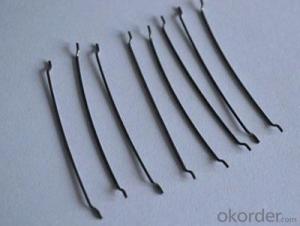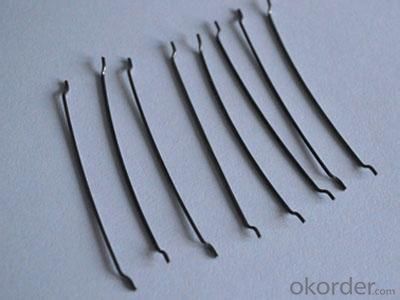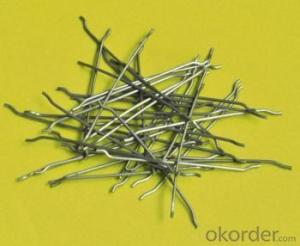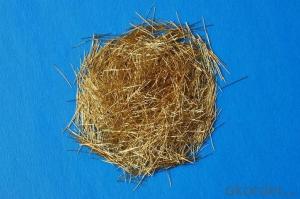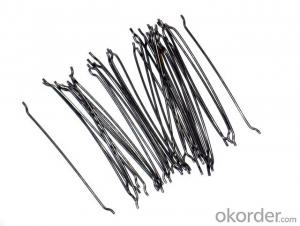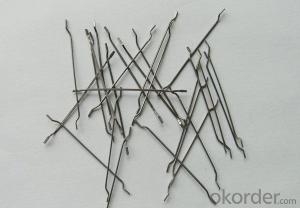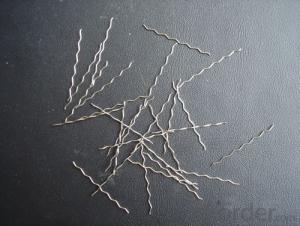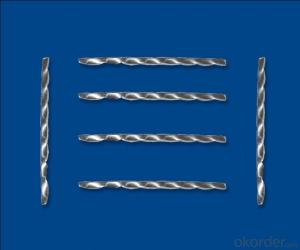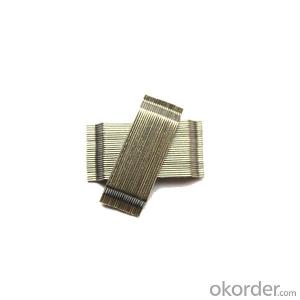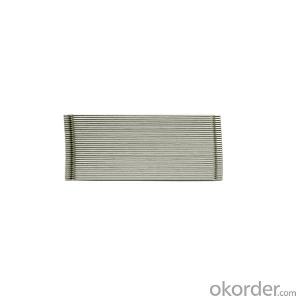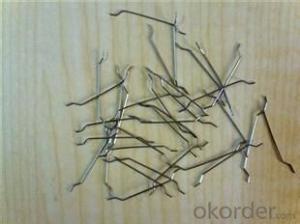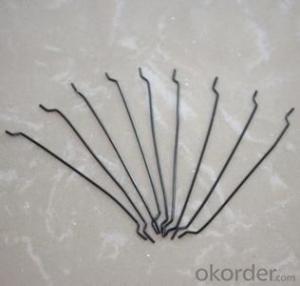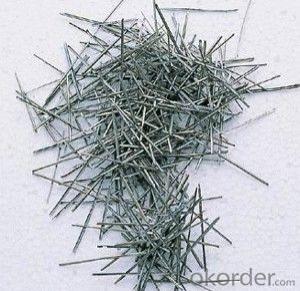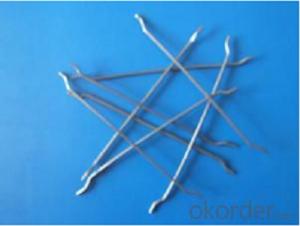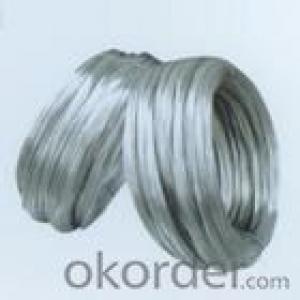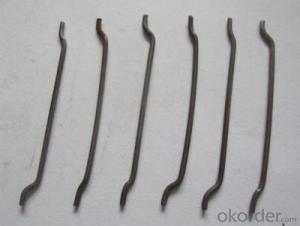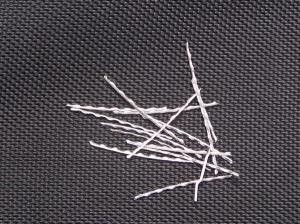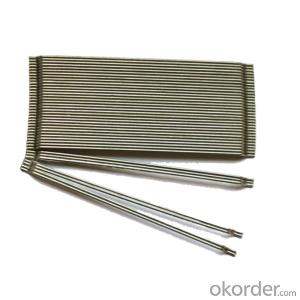Melt Extract Stainless Steel Fiber 0.55/30 Concrete Steel Fiber from CNBM China
- Loading Port:
- Tianjin
- Payment Terms:
- TT OR LC
- Min Order Qty:
- 1 m.t.
- Supply Capability:
- 5000 m.t./month
OKorder Service Pledge
Quality Product, Order Online Tracking, Timely Delivery
OKorder Financial Service
Credit Rating, Credit Services, Credit Purchasing
You Might Also Like
Quick Details
Place of Origin: Tianjin, China (Mainland)
Brand Name: Hengfeng
Model Number: 0.55
Material: Steel
Production Process: Cold drawn
Lengh: 30
Type: 1
Compressive Strength: >1200MPa
Aspect ratio: 55
Standard: ASTM A820M-11
Section Shape: Circular
Application: Concrete Reinforcement
Producing Area: Tianjin
Packaging & Delivery
| Packaging Details: | 20 kg/Bag,50 bags/Pallet or 1,000kg/ Bulk Bag |
|---|---|
| Delivery Detail: | 1 Month |
Product Description
| Diameter | 0.55 | mm | 0.02 | in |
| Length | 30.00 | mm | 1.18 | in |
| Aspect Ratio | 55 | |||
| Tensile strength | 1200 MPa | |||
| Type | Cold drawn Steel Fiber | |||
| End | Hooked-end Steel Fiber | |||
| Glued/Loose | Glued Steel Fiber | |||
| Bending Angle | 45°(min.30°) | |||
| Usage & Performance | Floor:Trafficked areas and Industrial floors | |||
| Shotcrete :Slope stabilization and Final lining | ||||
| Precast concrete:Pipe and Railway sleepers | ||||
| Packing | Standard Export Pallet Packing | Bag Packing | 20 kg/Bag,50 bags/Pallet | |
| Bulk Packing | 1,000kg/ Bulk Bag | |||
| Loading Quantity | 20’GP | 20-25 Tonne/Tonnes | ||
| 40’GP | 25-27 Tonne/Tonnes | |||
| 40’HQ | 25-27 Tonne/Tonnes | |||
| MOQ | 1 kg for trial order | |||
| Supply Ability | 10,000 Tonne/Tonnes per Year | |||
| Payment Terms | T/T or L/C at sight | |||
| Delivery Time | Within 15 days after receiving deposit or original L/C at sight | |||
| Certification | ISO9001:2000, CE, | |||

| Product | Diameter | Length mm/in | Aspect Ratio | Type | Packing |
| G-6030 | 0.5 mm (0.0197 in) | 30 mm (1.1811 in) | 60 | Glued | 20 kg/Bag, or 1,000kg/ Bulk Bag |
| G-6535 | 0.55 mm (0.0217 in) | 35 mm (1.3780 in) | 65 | Glued | 20 kg/Bag, or 1,000kg/ Bulk Bag |
| G-6035 | 0.6 mm (0.0236 in) | 35 mm (1.3780 in) | 60 | Glued | 20 kg/Bag, or 1,000kg/ Bulk Bag |
| G-8060 | 0.75 mm (0.0295 in) | 60 mm (2.3622 in) | 80 | Glued | 20 kg/Bag, 50 bags/Pallet |
| G-6060 | 0.9 mm (0.0354 in) | 60 mm (2.3622 in) | 60 | Glued | 20 kg/Bag, 50 bags/Pallet |
| G-6030 | 0.5 mm (0.0197 in) | 30 mm (1.1811 in) | 60 | Loose | 20 kg/Bag, or 1,000kg/ Bulk Bag |
| G-6535 | 0.55 mm (0.0217 in) | 35 mm (1.3780 in) | 65 | Loose | 20 kg/Bag, or 1,000kg/ Bulk Bag |
| G-6035 | 0.6 mm (0.0236 in) | 35 mm (1.3780 in) | 60 | Loose | 20 kg/Bag, or 1,000kg/ Bulk Bag |
| G-8060 | 0.75 mm (0.0295 in) | 60 mm (2.3622 in) | 80 | Loose | 20 kg/Bag, 50 bags/Pallet |
| G-6060 | 0.9 mm (0.0354 in) | 60 mm (2.3622 in) | 60 | Loose | 20 kg/Bag, 50 bags/Pallet |
- Q: Does melt extract stainless steel fiber affect the color or appearance of concrete?
- The color or appearance of concrete is not affected by melt extract stainless steel fiber. Typically, this fiber is included in concrete mixtures as a reinforcement material, rather than for aesthetic reasons. These fibers are typically small and thin, and when combined with the concrete, they seamlessly integrate with the other materials and do not change the color or appearance of the final product. The main purpose of melt extract stainless steel fibers is to enhance the concrete's strength and durability, making it more resistant to cracks and improving its overall performance.
- Q: Can melt extract stainless steel fiber be used in high-performance or self-compacting concrete?
- Yes, melt extract stainless steel fiber can be used in high-performance or self-compacting concrete. It enhances the mechanical properties of concrete, such as its strength, durability, and ductility. The addition of stainless steel fibers improves the crack resistance and flexural strength of the concrete, making it suitable for high-performance and self-compacting applications.
- Q: How does the addition of melt extract stainless steel fiber affect the durability of concrete?
- The addition of melt extract stainless steel fiber can greatly enhance the durability of concrete. Stainless steel fibers are known for their high tensile strength, corrosion resistance, and excellent durability properties. When these fibers are incorporated into concrete, they create a three-dimensional reinforcement network that significantly improves the concrete's resistance to cracking, spalling, and other forms of damage. The stainless steel fibers act as reinforcement within the concrete matrix, providing additional strength and toughness. This reinforcement helps to prevent the propagation of cracks, thereby reducing the risk of structural failure. The fibers also enhance the concrete's resistance to impact, abrasion, and fatigue, making it more durable in harsh environments or under heavy loading conditions. Furthermore, the corrosion resistance of stainless steel fibers ensures that the concrete remains robust even in aggressive environments. Unlike traditional steel reinforcement, which is susceptible to corrosion and can lead to concrete deterioration, stainless steel fibers remain unaffected by moisture, chemicals, and other corrosive agents. This resistance to corrosion extends the lifespan of the concrete structure and reduces the need for costly repairs or maintenance. Overall, the addition of melt extract stainless steel fiber significantly improves the durability of concrete. It enhances its strength, toughness, resistance to cracking, impact, abrasion, and fatigue, while also providing excellent corrosion resistance. This makes concrete structures more resilient, longer-lasting, and more cost-effective in the long run.
- Q: Can melt extract stainless steel fiber be used in water retaining structures?
- Yes, melt extract stainless steel fiber can be used in water retaining structures. This type of fiber is highly corrosion-resistant and can withstand exposure to water without compromising its performance. It can be incorporated into concrete or other materials used in water retaining structures to enhance their strength, durability, and crack resistance.
- Q: What is the effect of melt extract stainless steel fiber on the shrinkage and cracking of concrete?
- The use of melt extract stainless steel fiber in concrete can significantly reduce shrinkage and cracking. The fibers act as reinforcement within the concrete, enhancing its overall tensile strength and improving its resistance to shrinkage. This reinforcement helps to distribute stresses more evenly throughout the concrete, minimizing the formation of cracks and reducing their potential for propagation. Additionally, the stainless steel fibers also provide increased resistance to temperature changes and external loads, further reducing the likelihood of shrinkage and cracking in the concrete.
- Q: Can melt extract stainless steel fiber be used in concrete pipes or culverts?
- Concrete pipes or culverts can indeed utilize melt extract stainless steel fiber. The addition of stainless steel fibers to concrete offers numerous advantages, including heightened strength, durability, and crack resistance. These fibers enhance the overall functionality of concrete, rendering it perfect for implementation in pipes and culverts where robustness and longevity are of utmost importance. Moreover, the stainless steel's resistance to corrosion guarantees that the structural integrity of the concrete pipes or culverts remains intact, even in the face of harsh surroundings. Consequently, melt extract stainless steel fiber proves to be an appropriate option for reinforcing concrete pipes or culverts.
- Q: Can melt extract stainless steel fiber be used in nuclear power plant construction?
- Yes, melt extract stainless steel fiber can be used in nuclear power plant construction. These fibers possess high temperature resistance and excellent mechanical properties, making them suitable for applications in nuclear power plants where durability and strength are crucial. Additionally, they offer resistance to corrosion and radiation, which are important considerations in such environments.
- Q: Can melt extract stainless steel fiber be used in roller-compacted concrete applications?
- Yes, melt extract stainless steel fiber can be used in roller-compacted concrete applications.
- Q: Can melt extract stainless steel fiber be used in underwater concrete applications?
- Yes, melt extract stainless steel fiber can be used in underwater concrete applications.
- Q: How does the addition of melt extract stainless steel fiber affect the workability of concrete?
- By incorporating melt extract stainless steel fiber, the workability of concrete can be significantly affected. These fibers, which are thin strands, are mixed into the concrete during the mixing process. Typically, they are added in small percentages ranging from 0.5% to 2% by volume. When stainless steel fibers are added to concrete, one of the primary outcomes is an enhancement in workability. Workability, in this context, refers to how easily concrete can be mixed, placed, and finished. By improving the cohesiveness and flowability of the concrete mixture, stainless steel fibers make it more manageable and manipulable during construction. These fibers serve as reinforcement agents within the concrete, increasing its resistance to cracking, shrinkage, and deformation. Consequently, the overall strength and durability of the concrete are improved, making it more resilient against external forces and environmental conditions. Furthermore, the addition of stainless steel fibers can also improve the plasticity of the concrete, leading to better compaction and consolidation. As a result, the hardened concrete attains increased density and reduced porosity, thereby enhancing mechanical properties like compressive strength and flexural strength. Nevertheless, it is important to acknowledge that adding stainless steel fibers can also present some challenges to the workability of concrete. The fibers may cause the mixture to become slightly sticky, making it more difficult to handle and place. Additionally, the presence of fibers can increase the viscosity of the concrete, making it harder to pump and transport. In conclusion, by adding melt extract stainless steel fiber to concrete, its workability can be positively influenced through improved cohesiveness, flowability, and plasticity. Nonetheless, careful consideration of dosage and mix design is necessary to ensure that the desired workability is achieved without compromising other concrete properties.
Send your message to us
Melt Extract Stainless Steel Fiber 0.55/30 Concrete Steel Fiber from CNBM China
- Loading Port:
- Tianjin
- Payment Terms:
- TT OR LC
- Min Order Qty:
- 1 m.t.
- Supply Capability:
- 5000 m.t./month
OKorder Service Pledge
Quality Product, Order Online Tracking, Timely Delivery
OKorder Financial Service
Credit Rating, Credit Services, Credit Purchasing
Similar products
Hot products
Hot Searches
Related keywords
